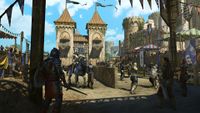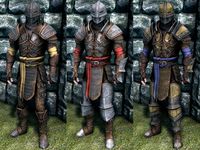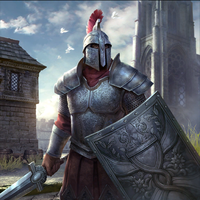Lore:Breton Knightly Orders
Breton society is famous for its knightly orders,[1] with notable examples including Daggerfall's Knights of the Dragon, the Knights of the Rose of Wayrest, the Knights of the Flame of Anticlere, and Dwynnen's Order of the Raven. Some Bretons served as knights under Clan Direnni sometime before the fall of the Direnni Hegemony.[2][3] However, it is commonly accepted that Bretons established their militant orders of knights when they became independent from Direnni elves. High Rock's cultural history is founded on tales of such noble and chivalrous knights, which supposedly fought for Breton Liberation and drove the Direnni back to Balfiera Isle. The knightly orders were founded to carry on the tradition of nobles-in-arms and to ensure the province would have defenders at the ready should invading armies come to their gates.[1] The Lion Guard was one such order before the formation of the Daggerfall Covenant in the Second Era.[4] Breton knights espouse the traditional chivalric principles of Breton society and are among the most prominent practitioners of High Rock's culture of questing.[5][6]
Historically, members that made up Breton knightly orders were high-born, for they provided a place to go for excess children of the nobility. As High Rock became more prosperous, the merchant class became an acceptable alternative qualification to join.[1] It is difficult for commoners to become knights, but having friends in high places can make becoming one easier.[7] Lady Joslin Garick is an example of a commoner becoming a knight.[8] Knighthood is used to confer a measure of nobility, and it can be granted to people of the lower classes as a reward for significant contributions to society. If the position was not achieved through conflict, the membership is nominal only. An example are the "merchant knights", who achieved the title through outstanding contributions to the economy. These merchants do not take up arms, but are instead expected to heavily contribute to their knightly order's finances.[1] Individuals from races other than Breton are allowed to join these orders as well.[9]
Most competent knightly orders require applicants to have some degree of martial knowledge or skill before they are considered for membership. Less reliable orders may grant promotions in rank over a knight's nobility, wealth, or charisma, but generally, a knightly order will require their members to be skilled warriors so as not to tarnish the group's reputation.[10] Etiquette, swordsmanship, archery and medical skill are factors considered when assessing potential recruits.[11] The spell-knight is an archetype that encapsulates the Breton staples of knighthood and the arcane,[12][13][14] while the druid-knight brings the druidic arts into the lifestyle of a knightly order.[15][16] Knights are addressed with the honor of "sir" or "dame." Knights subscribe to their own hierarchies and customs as dictated by their order. In most cases, these orders are governed by a marshal or a knight-commander. Regardless of the marshal's high station, their honorific remains the same.[17]
One of High Rock's most notable heroes was the Breton knight Eleidon in the First Era, owner of the eponymous shield.[18] The Reachfolk Witch-Knights were inspired to breed their own hardy steeds when they saw the strength and flair of the mounted Breton knights they fought during their invasion of High Rock.[19]
In older chivalric orders, heavy rings served as a knight's symbol of membership.[20] Each of the Eight Divines have their own templar knightly orders as the militant arm of their respective temples.[21]
Knightly Orders[edit]
High Rock[edit]
- Knights of the Dragon: Knightly Order of the Kingdom of Daggerfall.
- Knights of the Flame: Knightly order of Anticlere.
- Knights of the Owl: Knightly Order of Glenpoint.
- Knights of the Pale Order: Knightly Order in service to House Aurmine.
- Knights of the Rose: The Knights of the Rose are the protectors and warriors for the city and royal family of Wayrest.
- Knights of the Silver Rose: Avid crusaders against Daedra, they amassed a vast collection of Daedric relics in an attempt to keep them safely locked away from those who would seek to use their powers for ill.
- Order of the Crypt: Knightly Order that operates out of Shornhelm, dedicated to guarding the Crypt of Hearts.
- Order of the Cup: Knightly Order that are protectors of the Plessington Clan.
- Order of the Raven: Knightly Order of Dwynnen. Originally founded by Baron Othrok, they are reputed to be one of the most legendary knightly orders in all of High Rock, with high standards for recruits and accepting only the greatest warriors.[22]
- Order of Saint Pelin: Knightly Order of Evermore.
- The Lion Guard: Knightly Order that served as the elite and personal guardians of the Daggerfall Covenant's rulers. The order's tenets were to fight for the good of all High Rock and every Breton.[4]
The Systres[edit]
- Knights of Death's Valor: Knightly Order that stood for the ill-fated, not fearing death. Their base, Death's Valor Keep, acting as a bastion of their influence against the dark.[23]
- Oaken Order: Knightly Order that prioritizes magic and magical understanding over martial combat. Because of this, they have an intimate relationship with the druids, often citing the druidic teachers as the foundation for their high level of magical understanding. Oaken knights have been known to eclipse Mages Guild spellwrights in the areas of Destruction and Conjuring.[24]
- Order of the Albatross: Knightly Order that prides itself on its massive wingspan. Their numbers, both in active knights and percentage of Nirn explored, greatly exceeds that of other knightly orders based in the archipelago. This is made possible by the order's focus on adventure, discovery, and daring feats, which draws initiates from the mainland.[24]
- Order of the Braided Vine: Minor Druidic Knightly Order started by the Stonelore Circle to protect points of interest considered sacred to them. It is unknown if this order was created to pique interest into Druidism, or if it was a genuine attempt to meld their lifestyle into modern Breton culture.
- Order of Flame and Shadow: A mysterious Order in the Systres that some consider to be nothing more than a legend. Tomes and histories indicate this order is comprised of a sole knight who passes the mantle to a protege after an extensive and secretive training regiment. The Knight of Flame and Shadow had been sighted on a few occasions over the centuries, both working alongside the nobility and also actively entreating an uprising among the common folk.
- Order of the Iron Knot: Knightly Order that is known for their martial skills, which they hone on the road and at tournaments. Their founder, Baroness Belene Chatillon, sailed with the All Flags Navy itself. She fought the Sload, and lost an arm to Sload rot. In honor of her sacrifice and bravery, some members of the knightly order wear a black gauntlet on one hand.[24]
- Order of the Sacred Shield: A Knightly Order that served Lady Joslin Garick. Its last member moved on to the afterlife after the Sacred Shield was claimed by a worthy recipient in the Second Era.[8]
Templar Knightly Orders[edit]
Though some of these might not necessarily be Breton-made, these knightly orders have a significant prescence in High Rock around the Iliac Bay:
- Order of the Hour: The Order of the Hour serves as the militant arm of the Akatosh Chantry, and are dedicated to the Great Dragon's cause. They uphold the stability and permanence that he represents.[25] Though they have the origin as one of the oldest knightly orders in Imperial history,[26] they have most notably cemented their presence within the Kingdom of Wayrest.[25][27]
- Knights of the Circle: The Knights of the Circle serve the guardians of the Order of Arkay, and are as zealous as his priests. Members are expected to be skilled in combat, and are to swear unwavering loyalty to Ark'ay.[28]
- Order of the Lily: As knights of the House of Dibella, they are sworn to the ideals of their patron god.[29] While the priestesses of their temple are occupied with emanating pure beauty, the Order offers protection, and should they die in battle, they are to die gracefully.[30]
- Knights Mentor: The Knights Mentor serve the School of Julianos. They protect their patron god's influence by protecting their temple's endeavors to expand their wealth of knowledge, which in turn combats ignorance.[31]
- Kynaran Order: The Kynaran Order serves the Temple of Kynareth. Knights are expected to dedicate their mind, body, and sword to their patron god.[32]
- Maran Knights: The Maran Knights serve the Benevolence of Mara, but they are seen as controversial among those they protect. Although their existence is seen as hypocrisy, they are in a necessity, as military might is needed to protect the peace and love that Mara represents.[33]
- The Crusaders: The Crusaders (also called the Knights of Stendarr) serve the Temple of Stendarr. While their patron god represents ideals such as compassion and charity, without military strength, they cannot survive.[34]
- Knights of Iron: The Knights of Iron serve the Resolution of Z'en. They represent the warrior aspect of the God of Merchants and Commerce, and act as a deterrence to any that may interrupt trade.[35]
Notes[edit]
- Breton society is described as having an influence of Arthurian legends in it, in where "shining knights of old, set out on grand quests for adventure and glory".[UOL 1]
- Several additional knightly orders existed in earlier versions of Daggerfall that did not appear in the final version of the game, though their strings remain in the final version's data. They are noted in the Daggerfall Preview, and these include:
- The Gryphon Knights.
- The Knights of the Isle.
- The Order of the Lance.
- The Order of Nyeraad.
- The Border Knights.
- The Dreadknights.
- Additional templar orders appeared to be tied to several minor gods, including:
- The Knights of the Field, dedicated to Raen.
- The Order of the Wings, dedicated to Notorgo.
- The Wildlords, dedicated to Ephen.
- The Tide, dedicated to Vigryl.
- The Encyclics, dedicated to Jeh Free.
- The Order of the Key, dedicated to Q'Olwen.
Gallery[edit]
References[edit]
- ^ a b c d The Knightly Orders of High Rock — Lady Cinnabar of Taneth
- ^ Alana Relin and Commander Parmion's dialogue during A Step Back in Time in ESO
- ^ Knight of the Direnni passive during A Step Back in Time and The Nameless Soldier quests in ESO
- ^ a b The Improved Emperor's Guide to Tamriel: High Rock — Flaccus Terentius, 2E 581
- ^ Tamrielic Lore — Yagrum Bagarn
- ^ Dame Helenie's Quest — Sir Randyl of the Order of the Albatross
- ^ Albense Varin's dialogue in ESO
- ^ a b Cynric Ginise's dialogue in ESO: High Isle
- ^ Orlfeth the Valiant in ESO: High Isle
- ^ Traditions of the Lion Guard
- ^ List of required skills for all Knightly Orders in Daggerfall
- ^ Legacy of the Bretons — Stefan Mornard
- ^ Meet the Character - Sir Stefan Mornard — Knight Commander Jourvel
- ^ Crypt of the Heart - Draft — Ariana Dumas
- ^ Sir Stefan Mornard's dialogue in ESO
- ^ Systres Knightly Orders — Edana Augier, Knight Chronicler
- ^ Noble Ranks and Titles — Hercian, Steward at Castle Navire
- ^ Famed Artifacts of Tamriel — Yagrum Bagarn
- ^ Witch Knight Charger mount description in ESO
- ^ Ring of the Pale Order Antiquity codex entries in ESO
- ^ Temples and Templar Knightly Orders in Daggerfall
- ^ Faction information for the Order of the Raven in Daggerfall
- ^ Sir Nathain Galien's dialogue in Skyrim
- ^ a b c Systres Knightly Orders — Edana Augier, Knight Chronicler
- ^ a b Order of the Hour faction information in Daggerfall
- ^ Paladin's Mail description in Blades
- ^ Events that occur in the mission Kastus Thorn's House, Order of the Hour Barracks, and Temple of Akatosh in The Fall of the Dark Brotherhood
- ^ Knights of the Circle faction information in Daggerfall
- ^ Faction information for the House of Dibella and the Order of the Lily in Daggerfall
- ^ Generic Dialogue on the Order of the Lily in Daggerfall
- ^ Faction information on the Knights Mentor in Daggerfall
- ^ Kynaran Order faction information in Daggerfall
- ^ Faction information for the Maran Knights in Daggerfall
- ^ Faction information for the Crusaders in Daggerfall
- ^ Resolution of Zenithar faction information in Daggerfall
Note: The following references are considered to be unofficial sources. They are included to round off this article and may not be authoritative or conclusive.












